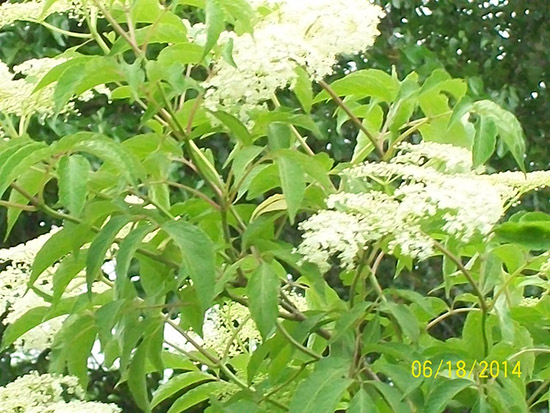Issue 9, June 30, 2014
Lesser Known "Weeds" -- Elderberry
On the heels of Kelly Estes' article, "Giant Confusion: Giant Hogweed and Common Look-Alikes" which can be found in the June 2 issue, I present you with one more look-alike: Elderberry (Sambucus nigra subsp. canadensis). This is one of a few lesser known species that I am commonly asked to identify.
Elderberry is quite common. It can be found in every Illinois' county and is in bloom now in central Illinois. Although this is a commonly seen species (especially when in bloom), many are not familiar with this native perennial shrub. It grows from 5 to 10 feet tall and has fairly large (4 to 6 inch) flower clusters of small white flowers that form flat, compound umbels. The large size and flower similarities between the two combined with an increase awareness of giant hogweed and its spread creates concern and confusion.

Elderberry shrub.

Elderberry.
Unlike giant hogweed, the leaves of elderberry are pinnately compound. An entire leaf is comprised of 5 to 11 oppositely arranged leaflets. Another difference is that giant hogweed does not produce berries. Elderberry has hanging clusters of blue-black, fleshy berries. And finally, elderberry does not possess sap that can cause burning and blistering on the skin making it safer to handle than giant hogweed.
Many do not view this plant as being a weed. In fact, the fruit is edible once cooked and can be made into pies and jams and wine. Be sure to properly identify the plant first! The berries are toxic when raw. For a short video and description of elderberry, click this link by the University of Florida Center for Aquatic and Invasive Plants: http://plants.ifas.ufl.edu/node/397.
For more information specific to Illinois, check out: http://www.illinoiswildflowers.info/trees/plants/cm_elder.htm. (Michelle Wiesbrook)
Author:
Michelle Wiesbrook